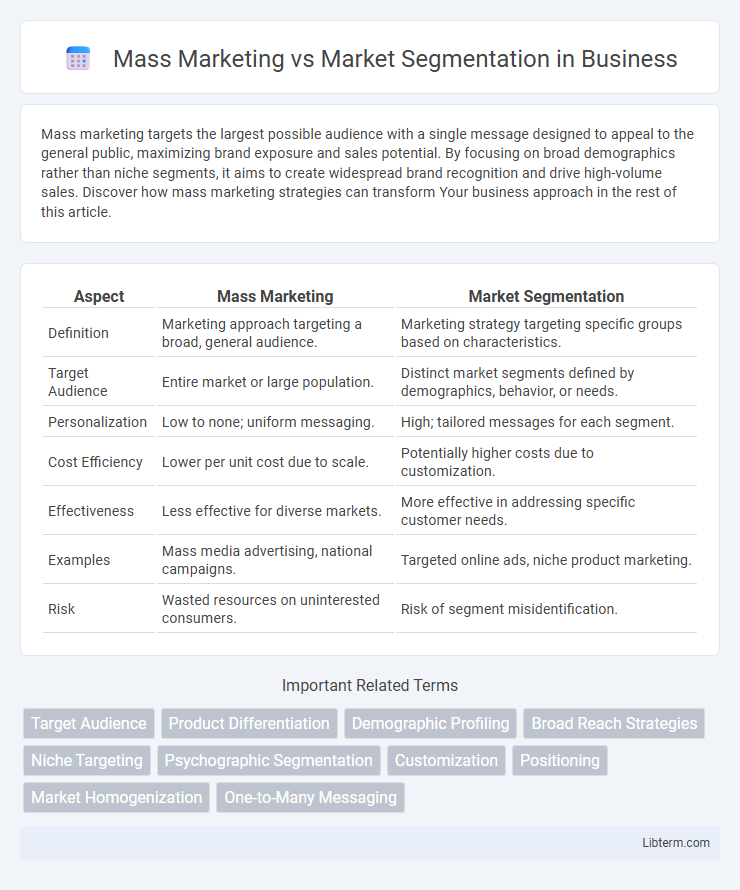Mass marketing targets the largest possible audience with a single message designed to appeal to the general public, maximizing brand exposure and sales potential. By focusing on broad demographics rather than niche segments, it aims to create widespread brand recognition and drive high-volume sales. Discover how mass marketing strategies can transform Your business approach in the rest of this article.
Table of Comparison
| Aspect | Mass Marketing | Market Segmentation |
|---|---|---|
| Definition | Marketing approach targeting a broad, general audience. | Marketing strategy targeting specific groups based on characteristics. |
| Target Audience | Entire market or large population. | Distinct market segments defined by demographics, behavior, or needs. |
| Personalization | Low to none; uniform messaging. | High; tailored messages for each segment. |
| Cost Efficiency | Lower per unit cost due to scale. | Potentially higher costs due to customization. |
| Effectiveness | Less effective for diverse markets. | More effective in addressing specific customer needs. |
| Examples | Mass media advertising, national campaigns. | Targeted online ads, niche product marketing. |
| Risk | Wasted resources on uninterested consumers. | Risk of segment misidentification. |
Understanding Mass Marketing: A Broad Approach
Mass marketing targets a wide audience with a single marketing strategy, emphasizing high product availability and uniform messaging to maximize reach. This approach leverages economies of scale and cost efficiency by avoiding customization, appealing primarily to common needs and preferences across the entire market. Brands such as Coca-Cola and McDonald's exemplify mass marketing by delivering standardized products and campaigns designed for universal consumption.
Defining Market Segmentation: Targeted Strategies
Market segmentation involves dividing a broad consumer or business market into sub-groups of consumers based on shared characteristics such as demographics, psychographics, geographic location, or behavior. This targeted strategy allows companies to tailor marketing efforts and product offerings to specific segments, increasing relevance and customer engagement. Unlike mass marketing, which aims at a wide audience with a uniform message, market segmentation enables personalized approaches that enhance conversion rates and customer loyalty.
Key Differences Between Mass Marketing and Market Segmentation
Mass marketing targets a broad audience with a single marketing strategy, aiming for high reach and uniform messaging across diverse consumer groups. Market segmentation divides the market into distinct groups based on demographics, psychographics, or behavior, enabling tailored marketing approaches that address specific needs. Key differences include the level of customization, with mass marketing focusing on sameness while segmentation prioritizes personalized communication for improved customer engagement and conversion.
Advantages of Mass Marketing
Mass marketing enables businesses to reach a broad audience quickly, maximizing brand exposure and driving high-volume sales with a uniform message. It reduces marketing costs per unit through economies of scale in advertising and production, making campaigns more cost-effective. This approach is especially effective for products with universal appeal, such as basic consumer goods and everyday essentials.
Benefits of Market Segmentation
Market segmentation enhances marketing effectiveness by tailoring products and messages to specific consumer groups, increasing customer satisfaction and loyalty. It enables companies to allocate resources efficiently, targeting high-potential segments to maximize return on investment. Businesses adopting market segmentation report improved competitive advantage by addressing unique needs and preferences within diverse markets.
Challenges Associated with Mass Marketing
Mass marketing faces challenges such as low customer engagement and inefficient resource allocation due to its broad approach that ignores individual consumer preferences. This strategy often results in limited personalization, making it difficult to address diverse market needs and leading to reduced conversion rates. Furthermore, mass marketing struggles with increased competition and market fragmentation, which diminish its overall effectiveness compared to market segmentation.
Limitations of Market Segmentation
Market segmentation faces limitations such as increased costs from tailored marketing campaigns and complex data analysis requirements. It can lead to over-segmentation, reducing economies of scale and diluting brand consistency. Additionally, inaccurate market data can result in ineffective targeting, diminishing overall marketing performance.
When to Use Mass Marketing vs. Market Segmentation
Mass marketing is effective when a product appeals to a broad audience with similar needs, such as basic consumer goods like toothpaste or household cleaners. Market segmentation is more advantageous when customer preferences vary significantly, allowing businesses to tailor messages and products to specific groups, such as luxury goods targeting affluent consumers. Companies should choose mass marketing for cost efficiency and maximum reach, while using market segmentation to enhance relevance and customer engagement in competitive or diverse markets.
Case Studies: Successful Examples of Both Strategies
Coca-Cola exemplifies mass marketing by using a consistent global message that appeals to a broad audience, driving worldwide brand recognition and sales growth. Conversely, Nike leverages market segmentation by tailoring products and marketing campaigns to specific demographics such as runners, basketball players, and women, resulting in increased customer loyalty and targeted engagement. Case studies from Procter & Gamble demonstrate hybrid success, combining mass marketing for flagship products like Tide with segmented campaigns for specialized brands such as Olay, optimizing reach and consumer relevance.
Future Trends in Marketing: Integration and Evolution
Mass marketing will evolve through advanced AI-driven analytics that enable broader personalization without sacrificing scale, while market segmentation will deepen with hyper-targeted strategies powered by real-time consumer data and machine learning. Integration of automated omnichannel platforms allows seamless blending of mass marketing efficiency and segmented precision, optimizing customer reach and engagement. Future marketing trends emphasize adaptive frameworks combining big data insights and dynamic segmentation models to enhance predictive accuracy and deliver tailored experiences at scale.
Mass Marketing Infographic

 libterm.com
libterm.com